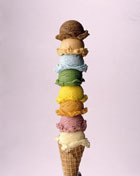Vol. V, No. 7, August/September 2005
- Editor's Corner
- What's happening with extreme sports?
- Which came first, the site or the feasibility study?
- What's cool for kids?
- Affordable Luxury, the new consumer paradigm
- KoalaPlay Group closes dry division
- Sensory overload coming at IAAPA Conference and Trade Show
- Healthy eating affects ice cream sales
- July issue correction
- Last Child in the Woods
- Chuck E. Cheese's opens 500th unit; summer campaign bombs
- Foundations announces 2006 dates and locations
- Peter Piper Pizza revamps its stores
- A mother's plea
Healthy eating affects ice cream sales
 The
trend toward healthier eating by American consumers is having an effect
on virtually all food products -- even in the traditionally self-indulgent
categories such as ice cream.
The
trend toward healthier eating by American consumers is having an effect
on virtually all food products -- even in the traditionally self-indulgent
categories such as ice cream.
Overall, ice cream sales have declined the past two years. According to ACNielsen Strategic Planner data, ice cream sales volume has dropped 6.7% from a high of 4.68 billion pounds during the 52-week period ending May 17, 2003, to 4.37 billion pounds in the 52-week period ending May 14, 2005. (ACNielsen Strategic Planner monitors sales in the food, drug and mass channels, excluding Wal-Mart.)
Still, ice cream is a tremendously popular treat. According to the ACNielsen Homescan consumer panel data, ice cream can be found in more U.S. households than toothpaste (86% to 85%). The U.S. Department of Agriculture reports that in 2004, 1.6 billion gallons of ice cream and frozen desserts were produced by American manufacturers. That's 21.5 gallons per year for every person, which means on average, Americans are eating about 1 2/3 quarts per week.
Ice cream manufacturers, intent on hanging on to all of those ice cream-buying households, are finding new ways to make ice cream healthier while maintaining its satisfying taste. According to ACNielsen LabelTrends, sales of healthy ice cream categories, with the exception of fat free, have all increased in the last year:
'Healthy segment' ice cream sales
| $ % change vs. year ago | |
|---|---|
| Low fat | 10.7% |
| Fat free | -8.6% |
| No sugar added | 0.7% |
| Less sugar | 510.2% |
| Sugar free | 11.9% |
| Reduced calorie | 21.8% |
52 weeks ending 5/14/05
Ice cream is just one example of how Americans' food preferences are changing, with a strong movement to what is perceived as healthier eating.
Wondering how your favorite ice cream flavor compares with that of the average American? According to the International Ice Cream Council, the top five flavors in descending order are vanilla, chocolate, butter pecan, strawberry and Neapolitan.
The IICC also reports that in 2002 Americans spent $12.5 billion
on ice cream and frozen desserts away from home (that's a lot of
ice cream cones) compared to $8.2 billion on in-home consumption.
Vol. V, No. 7, August/September 2005
- Editor's Corner
- What's happening with extreme sports?
- Which came first, the site or the feasibility study?
- What's cool for kids?
- Affordable Luxury, the new consumer paradigm
- KoalaPlay Group closes dry division
- Sensory overload coming at IAAPA Conference and Trade Show
- Healthy eating affects ice cream sales
- July issue correction
- Last Child in the Woods
- Chuck E. Cheese's opens 500th unit; summer campaign bombs
- Foundations announces 2006 dates and locations
- Peter Piper Pizza revamps its stores
- A mother's plea



